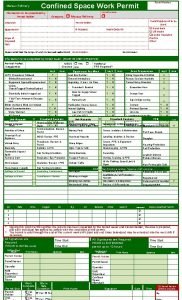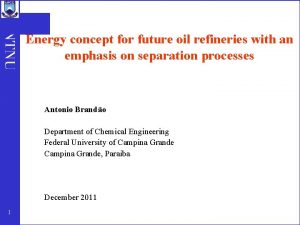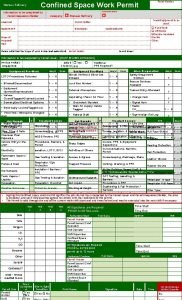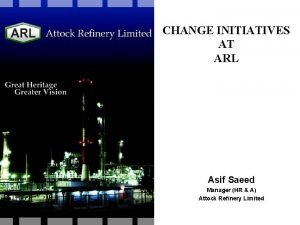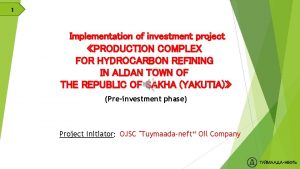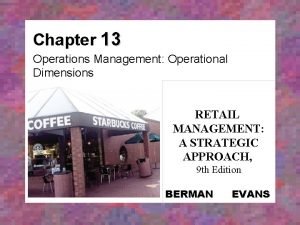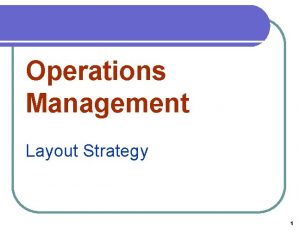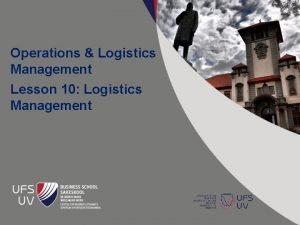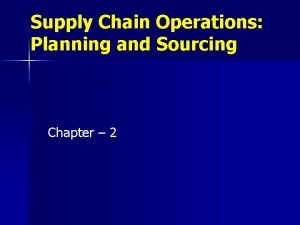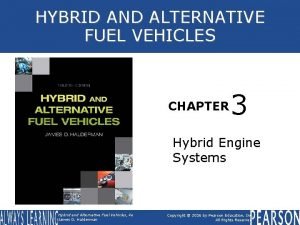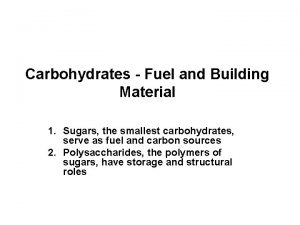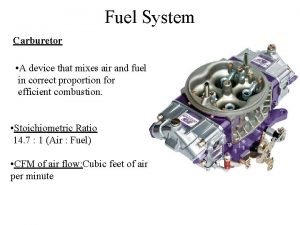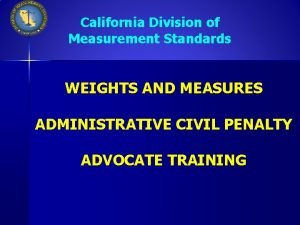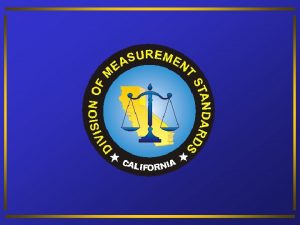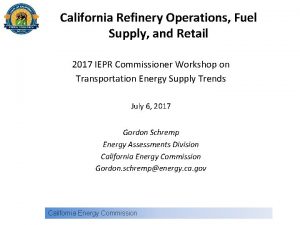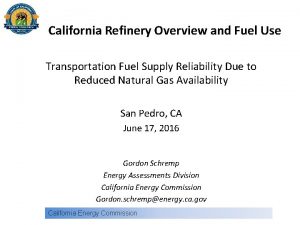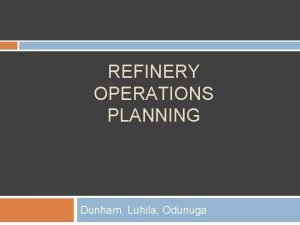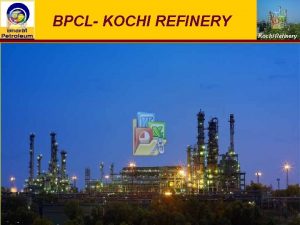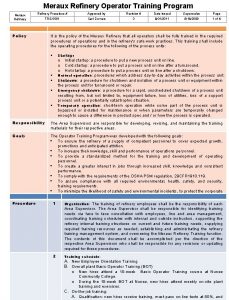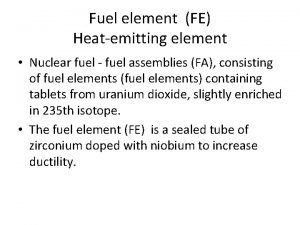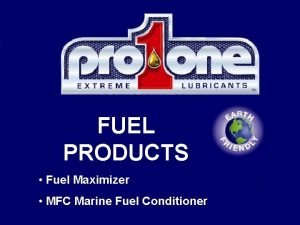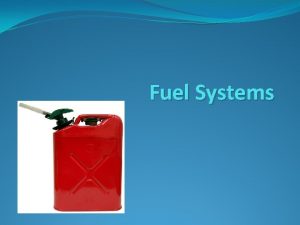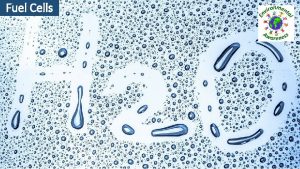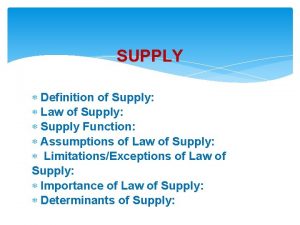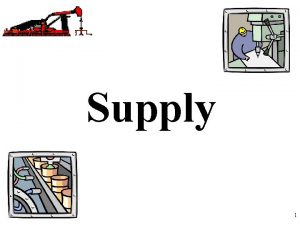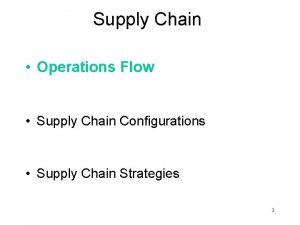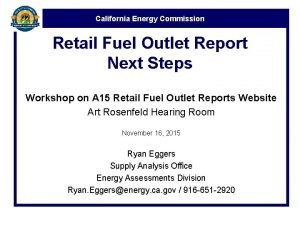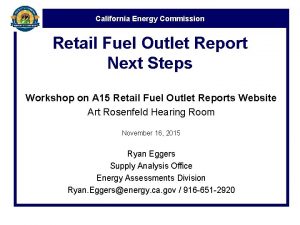California Refinery Operations Fuel Supply and Retail 2017









































- Slides: 41

California Refinery Operations, Fuel Supply, and Retail 2017 IEPR Commissioner Workshop on Transportation Energy Supply Trends July 6, 2017 Gordon Schremp Energy Assessments Division California Energy Commission Gordon. schremp@energy. ca. gov California Energy Commission

Presentation Topics • California refinery operations • Transportation fuel supply flows & trends • Retail operations – national & California 7/6/2017 California Energy Commission 2

California Refinery Operations 7/6/2017 California Energy Commission 3

Refineries – Historical Changes Pioneer Oil Refinery – Newhall - Circa 1877 • Initial refining operations date to 1870 s • 1982 – 40 operating refineries • 2. 565 MM barrels per day (b/d) capacity • • 61. 8 percent utilization rate 956 thousand b/d gasoline 241 thousand b/d distillates 184 thousand b/d jet fuel • 2016 – 15 operating refineries • 1. 884 MM barrels per day (b/d) capacity • • Source: SCV History. com 7/6/2017 California Energy Commission 85. 6 percent utilization rate 1, 007 thousand b/d gasoline 360 thousand b/d distillates 281 thousand b/d jet fuel • Increased complexity & higher utilization rates enable even greater fuel output with 62 percent fewer facilities 4

Refineries – Must Maintain Balance • Refiners must optimize operations to ensure system remains in balance: • • Steam load Sulfur plant operations Refinery gases Cogeneration operations & electrical loads • Hydrogen use • All refinery inputs end up being consumed or converted • Storage capacity is finite Source: Oil & Gas Journal 7/6/2017 California Energy Commission 5

California Refineries - Overview • Refineries are a primary hub of logistical activity • 15 refineries processed 1. 612 million barrels per day of crude oil during 2016 • 13 facilities produced California fuels • Crude oil during 2016 received by • • Marine vessels (foreign) – 887. 5 TBD Marine vessels (Alaska) – 188. 0 TBD California source via pipelines – 558. 5 TBD Rail/truck – 3. 0 TBD • Process units operate continuously at or near maximum capacity, except during periods of planned maintenance or unplanned outages 7/6/2017 California Energy Commission 6

Refinery Locations – Northern California Sources: Oil Change International map, Energy Information Administration refinery data, and Energy Commission analysis 7/6/2017 California Energy Commission 7

Refinery Locations – Southern California Northern California refiners all own their marine terminals, whereas the marine terminal docks in Southern California are owned by the cities of Los Angeles and Long Beach and leased to the refining & logistics companies (such as Kinder Morgan). Sources: Oil Change International map, Energy Information Administration refinery data, and Energy Commission analysis 7/6/2017 California Energy Commission 8

Product Slate of California Refineries (2016) Source: California Energy Commission 7/6/2017 California Energy Commission 9

Transportation Fuel Consumption Trends 7/6/2017 California Energy Commission 10

California Gasoline & Ethanol Consumption Although finished gasoline consumption declined 8. 9 percent between 2004 and 2012, strong recovery from the recession and continued population growth have pushed consumption up by 6. 9 percent between 2012 and 2016, edging closer to a record high. Ethanol use has increased from an average concentration of 3. 75 percent by volume in 2003 to 10. 09 percent by volume during 2016. Source: California Energy Commission analysis 7/6/2017 California Energy Commission 11

California Diesel Fuel, Biodiesel & Renewable Diesel Consumption Finished diesel consumption declined 15. 9 percent between the peak in 2007 and the trough in 2009. The strong recovery from the recession and associated goods movement by truck and rail pushed consumption back up by 15. 5 percent between 2009 and 2016. Source: California Energy Commission analysis 7/6/2017 California Energy Commission 12

California Jet Fuels and Aviation Gasoline Consumption Commercial jet fuel consumption declined 15. 1 percent between the peak in 2007 and the trough in 2009 (same pattern as diesel fuel). The strong recovery from the recession and associated rebound in air passengers and cargo have pushed consumption back up by 29. 9 percent between 2009 and 2016 to reach a new record high of 3. 87 billion gallons. Source: California Energy Commission analysis 7/6/2017 California Energy Commission 13

California Gaseous Fuel Consumption • The natural gas-based fuels usually displace diesel fuel • Hydrogen transportation fuel usually displaces gasoline in light-duty vehicles • Hydrogen consumption expected to rise through expanded fueling infrastructure & additional vehicle options 7/6/2017 California Energy Commission 14

California LCFS Credit Portion by Fuel Type Importance of biomethane increasing under the Low Carbon Fuels Standard. Source: California Air Resources Board 7/6/2017 California Energy Commission 15

California Transportation Electricity Consumption Light-duty transportation electricity consumption has grown from 62. 2 thousand MWhs in 2012 to 727. 0 thousand MWhs by 2016, an increase of more than ten times within four years – a direct consequence of the growing purchase of battery electric and plug-in electric vehicles. Sources: Federal Transit Administration & California Energy Commission analysis of DMV data 7/6/2017 California Energy Commission 16

Transportation Fuel Supply Flows & Trends 7/6/2017 California Energy Commission 17

Western States More Isolated than Rest of U. S. 7/6/2017 California Energy Commission 18

California Gasoline Market - Isolated • California’s gasoline market is nearly self-sufficient, so supplies of gasoline from outside of California are not routinely needed to balance out supply with demand – Imports of gasoline and blending components account for only 3 to 6 percent of supply • The California market is geographically isolated from other locations in the United States that produce refined products • Pipelines connect California refining centers to distribution terminals in Nevada and Arizona, but these pipelines only operate in one direction – sending gasoline and other transportation fuels to these neighboring states • California market is isolated by time and distance from alternative sources of re-supply during unplanned refinery outages 7/6/2017 California Energy Commission 19

Balance of Other Regions Varies • U. S. Gulf Coast (PADD 3) large net exporting region • During 2014, region consumed an average of 2. 5 million barrels per day (b/d) of transportation fuels yet produced 7. 5 million b/d • U. S. East Coast (PADD 1) large net importing region • During 2014, region consumed an average of 4. 9 million b/d of transportation fuels but only produced 1. 0 million b/d, representing 20 percent of the region’s supply 7/6/2017 California Energy Commission 20

Product Pipelines – Northern California • The pipeline infrastructure in California is controlled by a combination of common carrier and private companies • Kinder Morgan is the sole common carrier of petroleum product pipelines in the State and transports the majority of fuels through its system every day • Other companies, such as Chevron, Exxon. Mobil, Shell, and Tesoro operate proprietary systems or segments that handle the balance of transportation fuels 7/6/2017 California Energy Commission Source: Energy Commission revision to Kinder Morgan map 21

Gasolines Flows – Northern California 8 6 Imports into Northern California Pipeline Exports out of Northern California averaged roughly 500 thousand barrels per month over the entire time period. Remained unchanged in 2015. 5 4 Millions of Barrels per Month • Net exporter • Foreign imports rare • Domestic imports from WA refiners – steady • Imports from S. Calif. intermittent & small – refinery outages • Pipeline exports to Reno • Foreign exports growing • Domestic exports to PNW declined – replaced by WA refiners • Exports to S. Calif. normal portion of their supply – volumes fluctuate based on refinery outages 7 3 2 1 0 -1 -2 -3 -4 -5 -6 Exports out of Northern California -7 -8 Jan-07 Jan-08 Jan-09 Jan-10 Jan-11 Jan-12 Jan-13 Jan-14 Jan-15 Jan-16 NC FOREIGN IMPORT NC INTERSTATE IMPORT SOUTH TO NORTH TRANSFER NC INTERSTATE EXPORT NC FOREIGN EXPORT NORTH TO SOUTH TRANSFER NC PIPELINE EXPORT Source: California Energy Commission 7/6/2017 California Energy Commission 22

Diesel Flows – Northern California 8 7 6 Imports into Northern California 5 4 3 Pipeline Exports out of Northern California averaged roughly 450 thousand barrels per month over the entire time period. Diesel pipeline exports appear to be increasing from an average of 430 thousand barrels in 2007 to 500 in 2015 and 460 in 2016. Millions of Barrels 2 1 0 -1 -2 -3 -4 -5 -6 -7 Exports out of Northern California -8 Jan-07 Jan-08 Jan-09 Jan-10 Jan-11 Jan-12 Jan-13 Jan-14 Jan-15 Jan-16 NC FOREIGN IMPORT NC INTERSTATE IMPORT SOUTH TO NORTH TRANSFER NC INTERSTATE EXPORT NC FOREIGN EXPORT NORTH TO SOUTH TRANSFER NC PIPELINE EXPORT • Large net exporter • Foreign imports rare • Domestic imports from WA refiners – not needed • Imports from S. Calif. Intermittent & small – refinery outages • Pipeline exports to Reno • Foreign exports growing • Domestic exports to PNW small – replaced by WA refiners • Exports to S. Calif. unusual Source: California Energy Commission 7/6/2017 California Energy Commission 23

Product Pipelines – Southern California • Southwestern system includes portions to deliver transportation fuels into Southern Nevada and Arizona • NV – Over 85% of supply • AZ – Over 45% of supply • Dependency on Southern California refineries lessened by deliveries from West Texas and Utah 7/6/2017 California Energy Commission 24

UNEV System – Utah to Las Vegas • 427 -mile, 12 -inch refined products pipeline – 60, 000 bpd capacity • 600, 000 bbls storage capacity • Cedar City, UT • 2 truck loading bays & rail receipt • North Las Vegas, NV • 2 truck loading bays & truck receipt 7/6/2017 California Energy Commission 25

Gasolines Flows – Southern California 8 Imports into Southern California 7 6 5 Millions of Barrels per Month • Net importer via marine • Usually close to balance • Foreign imports when needed & economic • Domestic imports rare • Imports from N. Calif. normal portion of their supply – volumes fluctuate based on refinery outages • Pipeline exports to NV & AZ 4 3 2 1 0 -1 -2 -3 -4 -5 • 5 times N. Calif. volumes -6 • Foreign exports minimal • Domestic exports eliminated • Exports to N. Calif. rare – volumes fluctuate based on refinery outages -7 Exports out of Southern California Pipeline Exports out of Southern California averaged roughly 2. 4 million barrels per month over the entire time period. -8 Jan-07 Jan-08 Jan-09 Jan-10 Jan-11 Jan-12 Jan-13 Jan-14 Jan-15 Jan-16 SC FOREIGN IMPORT SC INTERSTATE IMPORT NORTH TO SOUTH TRANSFER SC INTERSTATE EXPORT SC FOREIGN EXPORT SOUTH TO NORTH TRANSFER SC PIPELINE EXPORT Source: California Energy Commission 7/6/2017 California Energy Commission 26

Diesel Flows – Southern California 8 7 6 Imports into Southern California 5 4 Pipeline Exports out of Southern California averaged roughly 1. 8 million barrels per month over the entire time period. Diesel pipeline exports appear to be decreasing from a rough average of 2 million barrels in 2007 to 1. 5 million in 2016. 3 Millions of Barrels 2 1 0 -1 -2 • 3 times N. Calif. volumes -3 -4 -5 -6 -7 • Large net exporter • Foreign imports when needed & economic • Domestic imports rare • Imports from N. Calif. Related to refinery outages • Pipeline exports to NV & AZ Exports out of Southern California -8 Jan-07 Jan-08 Jan-09 Jan-10 Jan-11 Jan-12 Jan-13 Jan-14 Jan-15 Jan-16 SC FOREIGN IMPORT SC INTERSTATE IMPORT NORTH TO SOUTH TRANSFER SC INTERSTATE EXPORT SC FOREIGN EXPORT SOUTH TO NORTH TRANSFER • Foreign exports declined • Domestic exports eliminated • Exports to N. Calif. rare – volumes fluctuate based on refinery outages SC PIPELINE EXPORT Source: California Energy Commission 7/6/2017 California Energy Commission 27

Retail Operations – National & California 7/6/2017 California Energy Commission 28

Retail – Historical Changes Servi-car Service at Union Oil Gas Station - 1932 • Initial filling stations 1905 to 1907 • 1908 – 300, 000 vehicles in operation • 1913 – 1 st drive-up station opens • Gulf Refining - Pittsburgh, Pennsylvania • Provided road maps • 1924 – 1 st gas credit cards issued • 1927 – 1 st convenience store opens • Southland Ice Co. – Dallas, Texas • Changes name to 7 -Eleven • 1947 – 1 st self-serve store opens • Frank Urich – Los Angeles, California • 1964 – 1 st self-serve auto dispensers • No attendant needed – Westminster, Colorado Source: Theoldmotor. com • 1986 – 1 st pay-at-the-pump dispensers • Auto. Gas – Abilene, Texas Source: NACS History of Fuels Retailing 7/6/2017 California Energy Commission 29

U. S. Convenience Store Ownership (2016) 154, 535 convenience stores of which 123, 807 were selling transportation fuels. These sales represented over 80 percent of the fuel sold in the U. S. during 2016. As of June 2016, the top five vertically integrated oil companies (Chevron, Shell, Exxon. Mobil, BP, and Conoco. Phillips) only owned and operated 0. 25 percent of the convenience stores selling transportation fuel. Sources: NACS/Nielsen 2017 Convenience Industry Store Count 7/6/2017 California Energy Commission 30

U. S. Convenience Stores – Pretax Profits Pretax profits have jumped 42. 3 percent from the 2011 -13 average of $47, 480 per store to the 2014 -16 average of $67, 605 per store. Sources: NACS State of the Industry Reports data 7/6/2017 California Energy Commission 31

U. S. C-Stores – Revenue & Fuel Profits Fuel sales represent majority of revenue but are less than 40 percent of pretax profits. Contribution has been growing since 2010. Sources: NACS State of the Industry Reports data 7/6/2017 California Energy Commission 32

California Annual Retail Fuel Survey • California Energy Commission conducts annual survey of locations dispensing transportation fuels to public • Traditional gas stations, card locks, marinas & municipal airports • Estimate total number of operating stations based on survey results • Can calculate average sales by county and type of station 7/6/2017 California Energy Commission 33

California Gasoline Sales by County (2015) • Los Angeles County top sales volume – 3. 465 billion gallons or 22. 9 percent of statewide totals • Top 5 counties are located in Southern California and account for 8. 191 billion gallons or 54. 2 percent of statewide totals • Chart volumes in millions of gallons Source: California Energy Commission 7/6/2017 California Energy Commission 34

California Average Monthly Gasoline Sales by Site (2015) • Statewide average gasoline sales – 133, 500 gallons per month by retail location • Orange County top average – 184, 200 gallons per month per station • Majority of the counties above the statewide average sales volume are urban • Chart volumes in thousands of gallons per month by location Source: California Energy Commission 7/6/2017 California Energy Commission 35

California Diesel Sales by County (2015) • Los Angeles County again top sales volume – 313 million gallons or 16. 1 percent of statewide totals • Unlike gasoline, most of the top counties have significant agricultural activities (like Kern and San Joaquin) • Chart volumes in millions of gallons Source: California Energy Commission 7/6/2017 California Energy Commission 36

California Average Monthly Diesel Sales by Site (2015) • Statewide average diesel sales – 17, 700 gallons per month by retail location • Tehama County top average – 96, 300 gallons per month per station • Majority of the counties above the statewide average sales volume are rural in nature & have agricultural activity • Chart volumes in thousands of gallons per month by location Source: California Energy Commission 7/6/2017 California Energy Commission 37

Top Five Hypermarket Companies Selling Fuel Hypermarketers are a more recent entrant to the retail fuels business. These locations dispense twice as much fuel as a typical service station in the U. S. Greater volumes and lower overhead usually enable very competitive pricing for consumers. Sources: NACS/Energy Analysts International 7/6/2017 California Energy Commission 38

California Gasoline Sales by County – Non. Hypermarts vs. Hypermarts (2015) • California Hypermarketers or Hypermarts sell even more gasoline compared to the U. S. locations – an average of 5. 3 times more compared to non-hypermart locations • Excludes marinas, resorts, card locks & general aviation airports not normally accessible to the typical motorist • San Mateo County has the highest average volume – 1. 171 million gallons per month per site • Tulare County shows the largest ratio – 16. 8 times greater than the nonhypermart locations • San Mateo County has the largest ratio for an urban region at 8. 7 times • Chart volumes in thousands of gallons Source: California Energy Commission 7/6/2017 California Energy Commission 39

U. S. Fueling Costs for Gasoline Declining Sources: Oil Price Information Service (OPIS) and CSP Magazine – May 2017 7/6/2017 California Energy Commission 40

Additional Q & A 1896 - Pacific Coast Oil Co. – 1 st Oil Tanker 1936 – Service With A Smile 1902 – Richmond Refinery Opens – 3, 000 b/d Capacity 7/6/2017 California Energy Commission Circa 1900 s – 750 Gallon Capacity 41
 Shell and tube heat exchanger in oil refinery
Shell and tube heat exchanger in oil refinery Shell and tube heat exchanger in oil refinery
Shell and tube heat exchanger in oil refinery Pre heat exchanger
Pre heat exchanger Types of recuperator
Types of recuperator Numaligarh oil refinery in assam map
Numaligarh oil refinery in assam map Peas for refinery controller
Peas for refinery controller Meraux refinery
Meraux refinery Refinery of the future
Refinery of the future Water refinery
Water refinery Meraux refinery
Meraux refinery Ewtub
Ewtub Kenexa refinery
Kenexa refinery Khabarovsk refinery
Khabarovsk refinery Retail communication objectives
Retail communication objectives Organised retailing
Organised retailing Retail management and operations
Retail management and operations Retail management strategy
Retail management strategy What is a tcs food
What is a tcs food Objective of retail store operations
Objective of retail store operations Process-oriented layout example
Process-oriented layout example Layout strategy example
Layout strategy example Retail layout operations management
Retail layout operations management Layout strategies examples
Layout strategies examples Retail layout operations management
Retail layout operations management Logistics management introduction
Logistics management introduction Introduction to operations and supply chain management
Introduction to operations and supply chain management Operations research and supply chain
Operations research and supply chain Chapter 5 section 1 supply and the law of supply
Chapter 5 section 1 supply and the law of supply Matching supply and demand in supply chain
Matching supply and demand in supply chain Scor reference model
Scor reference model Supply chain operations planning
Supply chain operations planning Ang pagbabago sa suplay ay dahil sa
Ang pagbabago sa suplay ay dahil sa Fossil
Fossil Fuel pressure regulator diagram
Fuel pressure regulator diagram Carbohydrates serve as fuel and building material
Carbohydrates serve as fuel and building material Positives of fossil fuels
Positives of fossil fuels Device which mixes air and fuel
Device which mixes air and fuel California map to inclusion and belonging
California map to inclusion and belonging Weights and measures violations
Weights and measures violations Fish and shellfish identification chapter 34
Fish and shellfish identification chapter 34 California weights and measures
California weights and measures Ece workforce registry
Ece workforce registry






